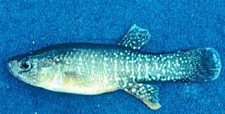Wildlife - Species

Mummichog (Fundulus heteroclitus)
Description
Mummichogs, locally called mud minnows, belong to a group of fishes known collectively as killifish. Killifish are members of the family Cyprinodontidae. They make up a large portion of the small fish in tidal creeks, saltwater marshes, lagoons, and other shallow coastal habitats. Mummichogs have a single, spineless dorsal fin and pelvic fins positioned near the anal fin. The head is flattened and the mouth is tilted upwards. Most species in the family Cyprinodontidae are sexually dimorphic; that is, males and females look different. Small female mummichogs are brownish above and pale below with 12-15 dark vertical bars. The dorsal and anal fins are tinged with green. Distinctive markings disappear as females grow larger. Males are darker in color, usually dark green or olive with a yellowish underside; spawning males have a dark spot towards the rear of the dorsal fin. Their sides are silvery with approximately 15 vertical bars and many small spots that continue on to the f in membrane, varying in color from white to yellow. Maximum adult size is 12 cm (4.7 in), with females growing larger than males.
Preferred Habitat and Biology
This species is very common along the eastern U.S. coast, from the Gulf of St. Lawrence to northern Florida. Mummichogs are especially abundant in salt marshes and tidal creeks of the ACE Basin and coastal South Carolina. The spawning season extends from spring to fall and varies with latitude. During this time, male mummichogs become brighter in color. Spawning takes place during the new or full moon (when the tide is at its highest) in water of various salinities. Eggs may be laid in a variety of substrates, depending on availability. Mummichog eggs may be found in the empty shells of ribbed mussels, on the leaves of marsh grass, in pits dug out and covered by the female, or spread directly on the bottom. The eggs develop out of the water, and hatching takes place upon immersion during the successive moon tide. Mummichogs are extremely hardy and can tolerate widely fluctuating environmental conditions. During winter months, they may burrow in the mud or move to deeper water at the mouths of channels. The word "mummichog" comes from an Indian word meaning "going in crowds." Various age classes will gather, often close to shore, in schools that may number several hundred fish. Feeding occurs at the marsh surface, in mid-water, or on the bottom even though this species' upward tilted mouth is specialized for surface feeding. Mummichogs eat a variety of foods including marine worms, crustaceans, small shrimps, insects, and other fish.
Species Significance
Mummichogs are an important food source for many commercially valuable fish species, as well as wading birds and seabirds. They are an important link in the coastal food chain. Mummichogs have little commercial (small industry for selling as bait) and no recreational value. Mummichogs and other species of killifish are used extensively in scientific studies, including medical and environmental research, and have been introduced to many areas for controlling mosquito larvae.
References
Abraham, B. 1985. Species profiles: Life histories and environmental requirements of coastal fishes and invertebrates (mid-Atlantic)--Mummichog and Striped Killifish. U.S. Fish and Wildlife Service Biological Report 82 (11.40). U.S. Department of Interior, Washington, D.C.
Boschung, H.T,. Jr., J.D. Williams, D.W. Gotshall, D.K. Caldwell, and M.C. Caldwell. 1983. The Audubon Society field guide to North American fishes, whales and dolphins. Alfred A. Knopf, New York, NY.
Murdy, E.O., R.S. Birdsong, and J.A. Musick. 1997. Fishes of the Chesapeake Bay. Smithsonian Institution Press, Washington, DC.
